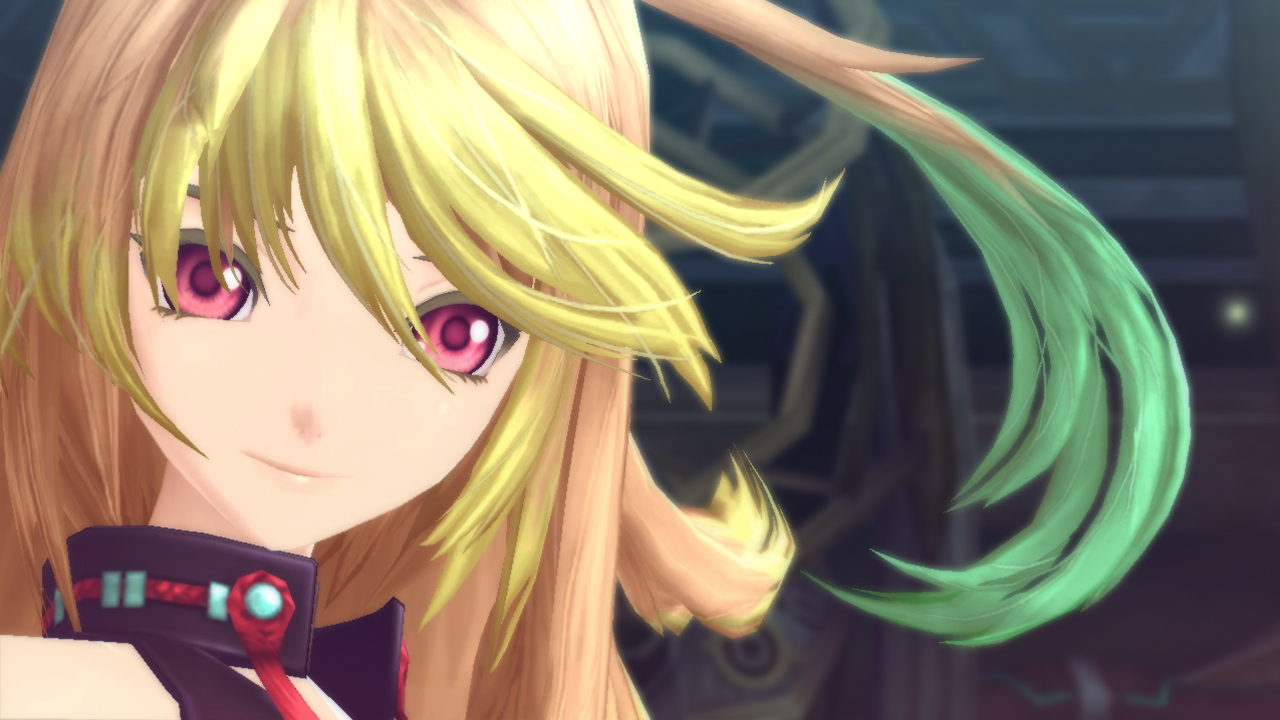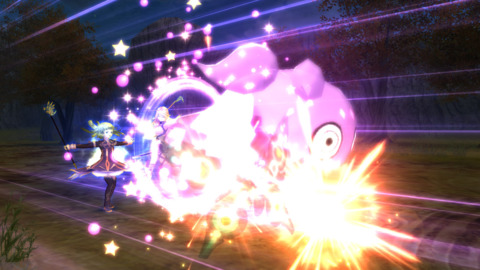Namco Bandai's Tales series of role-playing games has had a long, strange, on-again-off-again existence outside of Japan, with the series being localized in bursts only to subside in years-long lulls. Fortunately for fans, the series seems to be back in on-again mode, starting with the Tales of the Abyss 3DS rerelease and last year's Tales of Graces f for the PlayStation 3. Now, almost two years after Tales of Xillia's Japanese release, Western gamers get to play the game, the series' 15th-anniversary project. But while Xillia has high aspirations, some issues keep it from being the exemplary Tales release that its high profile might suggest.

Tales of Xillia is unique in the series in that it lets you select one of two protagonists at the game's beginning. Jude is a young medical student with some combat training who stumbles upon a dark secret at his school, while Milla is an almost godlike being who is being guided by the world's great spirits to destroy the foul experiments. The two first cross paths as Milla is invading the school's research facility, and a twist of fate results in Milla losing control of her immense powers and the pair going on the lam to escape military forces. Along the way, they meet a variety of enjoyable supporting cast members as is typical for the Tales series: a mercenary with ambiguous motives, a strange little girl with a boisterously chatty (and combat-capable) stuffed critter companion, the girl-next-door best friend/unrequited love, and--perhaps the most interesting of the bunch--a gray-haired, sophisticated combat butler.
One of the series' greatest strengths has always been its character interactions, and Tales of Xillia does not disappoint on this front. Cutscenes for important story events are plentiful and are depicted either through animated sequences or well-choreographed, in-engine scenes with full voice-over. Besides presenting story information, these scenes play out in a way that adds a lot of depth to the cast. Optional skits you can choose to view throughout the game use the more typical Japanese role-playing game method of mostly still character portraits augmented by fully voiced dialogue. These skits usually expound upon events encountered in the game, elements of the environment, or particular character quirks. They add a great deal of personality and appeal to the characters. Of course, these wouldn't be as effective if the characters themselves weren't enjoyable to be around. Everyone has a distinct, pleasant personality that makes you want to see more of their exchanges.
The world itself is interesting, thanks mostly to the stunning visuals. Tales has always gone for a colorful, anime-inspired look, and the graphics in Xillia play into this perfectly, featuring gorgeous, vivid landscapes and striking architecture. Character models are lovely, with things like Milla's outrageously poofy hair being rendered down to minute details. The camera isn't fixed like in other games in the series, so you can freely explore and enjoy the world's sights from almost any angle you please. There's a ton of in-world terminology being bandied about from the game's outset, but the most engaging element of Xillia's setting--and perhaps the biggest reason to save this world from ruin--is simply how visually sumptuous it is.

Fast-paced, real-time combat is another of Tales' defining elements, and Xillia does not disappoint on this front. You take control of a single character, while the CPU controls the other three based on settings and commands that you specify. Party members and enemies roam freely around the battlefields, exchanging attacks, dodges, and guards with real-time controller motions. Positioning and area-of-effect spells play huge roles in fighting well, along with chaining basic attacks into considerably more damaging (but resource consuming) arte strikes. In addition, some characters can perform "shifts," where certain commands transform an arte into a completely different (and generally more powerful) ability in exchange for making you more vulnerable to enemies.
New to Xillia's combat is the ability to link to another party member. By linking to another character, you gain specific benefits, the most immediate of which is that character's support proclivities. Linking with Jude, for example, has him helping to flank enemies, healing you when your HP runs low, and helping you recover from knockdowns. Meanwhile, linking with Rowen allows him to help protect you from foes' magical attacks. A gauge in the lower left corner of the screen fills as blows are traded, and when it reaches certain points, you have the chance to execute a powerful link arte at the end of combo strings with your linked partner. When the gauge fills completely, you can go into "over limit," which allows unlimited link artes to be chained together for a brief period of time. Links between your controlled character and others can be swapped at will during fights--even during link chains, with the right timing--so learning to use them well adds a great deal of depth to fighting.
There are some questionable design decisions that make the experience less than what it should be.
Outside of combat, character abilities can be augmented through individual characters' lillium orbs, which are geometric grids with stat gains, skills, and combat artes nestled within a series of orbs and webs that you connect from points gained from leveling up in combat. The system offers some element of customization, but since certain areas of the orb need to be unlocked to expand the grid, you tend to be biased toward enhancing the particular stats the game's designers emphasize. There is a small amount of freedom--for example, since Elize can swap between being more physical or magic-oriented during combat, you may try to focus on which one you prefer for her--but most players will find that their parties' skill sets are similar at game's end.

But while so much of Xillia is impressive, there are some questionable design decisions that make the experience less than what it should be, particularly for longtime franchise fans. The most glaring is the dual protagonist system, which sounds like a fantastic idea on paper: you pick one of two main characters at the beginning and get to see the game's major events through that character's eyes, which increases the incentive to come back after you've finished the game to revisit the story from the other character's point of view. Unfortunately, it's handled poorly: since Jude and Milla sometimes partake in completely separate activities, when they reunite, you're stuck hearing an all-too-brief summary of what important events happened to the other person. When you have drastic, story-altering events such as party member recruiting, double-crosses and shocking twists, and character deaths happening offscreen, only to be given a CliffsNotes version after the fact, the plot starts to feel confusing. It's especially bad toward the game's end, when huge things happen for both characters; not seeing the whole story makes the all-important endgame revelations incoherent. It's practically required to play through the game twice if you want to have any idea of what happened.
Much like Tales of Graces f, Xillia lacks a world map, though fast travel becomes available fairly early on in the game. Instead, areas are connected by stretches of land filled with roving beasts eager for a taste of your party. The game's structure, however, boasts none of the dungeons and accompanying puzzles, another beloved staple of the series. While the connectedness of the game's major locales makes the world feel more engaging and coherent, the lack of distinct, dangerous locales to solve mysteries in takes some bite out of the exploration element. Most of the puzzle-solving and big-monster-killing is instead relegated to sub-quests in preexisting locations, meaning that you'll see a lot of the same places over and over if you're a completionist. It's a real shame, since the beautiful graphics leave you eager to see what more could be done to make the world come to life.

Other odd changes include new systems for shopping and cooking. The previous Tales release, Tales of Graces f, featured a fun system where you could find materials to upgrade items, transforming weak gear into powerful equipment, and it made you carefully consider your options before buying and selling old stuff. Tales of Xillia feels like a step back in this regard; all of the stores in the game feature the same stock of goods, and you instead contribute supplies and money to help "upgrade" the shops so they will carry new stuff and offer discounts. Besides not making much economic sense, it strips away a fun element of visiting RPG locales: seeing what new and unique goods each town has to offer. In addition, the traditional cooking system where you learn recipes and use ingredients for combat-enhancing boosts has been replaced with buying premade dishes, of which you can hold only one of at a time. It's a strange change that reduces the enjoyment and effectiveness of a long-established series element.
Tales of Xillia is certainly a solid game, but it feels like it could have been better. The visuals are fantastic, the combat is great, and the characters are wonderful, but the lacking story presentation and exploration elements drag down what could have been one of the best JRPGs on the PlayStation 3. Tales of Xillia 2 has already been announced for an English release, so there is hope that the sequel will fix this game's issues, but for the time being, we have the original game in all of its fun-but-flawed existence.